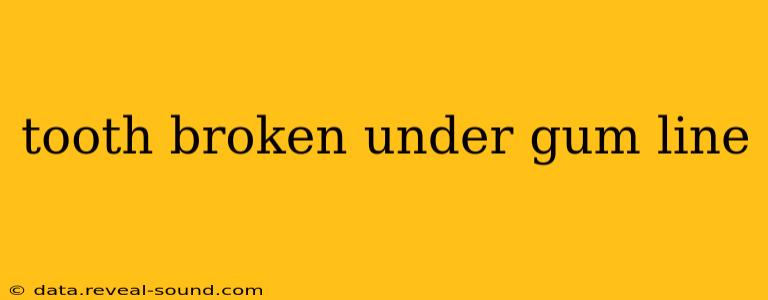A broken tooth under the gum line is a serious dental emergency requiring immediate professional attention. The severity depends on the extent of the fracture and whether the nerve is involved. Ignoring the problem can lead to infection, abscess formation, and ultimately tooth loss. This comprehensive guide will address common concerns and provide actionable steps.
What Happens When a Tooth Breaks Below the Gum Line?
When a tooth fractures below the gum line, the exposed dentin and potentially the pulp (the tooth's nerve) are vulnerable to bacteria. This can cause significant pain, inflammation, and infection. The damage is often unseen, making diagnosis crucial. The fractured portion may be loose or completely detached, further complicating the situation. The extent of the damage often dictates the necessary treatment.
How Do I Know if My Tooth is Broken Under the Gum Line?
Identifying a subgingival (below the gum line) fracture can be challenging as it’s often hidden from view. However, several signs indicate a potential problem:
- Severe pain: Especially when biting down or consuming hot or cold foods/drinks.
- Swelling: Around the affected tooth and gum.
- Sensitivity: Increased sensitivity to temperature changes or pressure.
- Loose tooth: A feeling that the tooth is loose or shifting.
- Discoloration: The tooth might appear darker than usual.
- Pus: The presence of pus indicates an infection.
What are the Treatment Options for a Tooth Broken Below the Gum Line?
Treatment varies considerably depending on the extent of the fracture and the condition of the tooth's root and pulp. Options include:
- Root Canal: If the pulp is infected or exposed, a root canal is usually necessary to remove the infected tissue, clean the canals, and seal them to prevent further infection. This is often followed by a crown.
- Crown: A crown (dental cap) covers the damaged tooth, restoring its shape, strength, and function. It protects the tooth from further damage and helps prevent complications.
- Extraction: In severe cases where the tooth is extensively damaged, beyond repair, or the root is fractured, extraction may be the only option. This might be followed by an implant, bridge, or partial denture to replace the missing tooth.
- Dental Implants: Implants are artificial tooth roots surgically placed into the jawbone to serve as anchors for replacement teeth. They provide a strong, permanent solution.
How Much Does it Cost to Repair a Tooth Broken Under the Gum Line?
The cost of repairing a tooth broken below the gum line varies depending on several factors: the extent of the damage, the necessary treatment, your location, and your dentist's fees. Root canals, crowns, and implants are significant investments. It's always recommended to contact your dentist or multiple dentists for estimates to compare and find the best solution and cost.
Can a Tooth Broken Under the Gum Line Heal on Its Own?
No, a tooth broken under the gum line will not heal on its own. The fracture provides an entry point for bacteria, leading to infection and further damage. Prompt professional intervention is essential to prevent complications and save the tooth.
What Happens if I Don't Treat a Tooth Broken Below the Gum Line?
Ignoring a subgingival fracture can lead to several serious consequences:
- Severe pain and infection: The infection can spread to surrounding tissues, causing significant pain, swelling, and potentially a dental abscess.
- Tooth loss: The infection and damage can weaken the tooth, leading to its eventual loss.
- Bone loss: Severe infection can damage the supporting bone structure of the jaw.
- Spread of infection: In rare cases, the infection can spread to other parts of the body, causing systemic problems.
How Can I Prevent a Tooth from Breaking Below the Gum Line?
While accidents can happen, taking preventative measures can significantly reduce the risk:
- Wear a mouthguard: During contact sports or activities that may put your teeth at risk.
- Practice good oral hygiene: Brush and floss regularly to maintain strong teeth and gums.
- Avoid chewing on hard objects: Such as ice, pens, or hard candies.
- See your dentist regularly: For check-ups and professional cleanings to detect and address potential problems early.
This information is for general knowledge and does not constitute medical advice. It is crucial to consult a dentist immediately if you suspect a tooth is broken under the gum line for proper diagnosis and treatment. The sooner you seek professional help, the better the chances of saving the tooth and preventing further complications.
